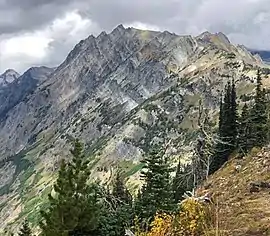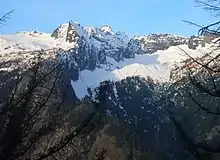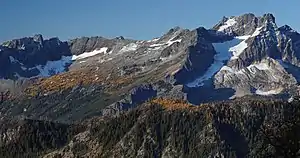Brahma Peak
Brahma Peak is a remote 8,078-foot (2,462-metre) mountain summit located on Chiwawa Ridge in the North Cascades, in Chelan County of Washington state. The mountain is situated in the Glacier Peak Wilderness, on land managed by the Wenatchee National Forest. Its nearest higher neighbor is Buck Mountain, 1.8 mi (2.9 km) to the north. Brahma and Buck are set on Chiwawa Ridge, and other notable peaks on this ridge include Fortress Mountain, Cirque Mountain, Napeequa Peak, Mount Berge, Bandit Peak, and Chiwawa Mountain. Precipitation runoff from Brahma and meltwater from its glacier remnants drains into Chiwawa River and Napeequa River, both tributaries of the Wenatchee River. Topographic relief is significant since the southwest lavender-colored schist cliffs of this peak rise nearly 4,000 feet above the Napeequa River Valley in approximately one mile.
| Brahma Peak | |
|---|---|
 Southeast aspect, from Little Giant Pass | |
| Highest point | |
| Elevation | 8,078 ft (2,462 m) [1][2] |
| Prominence | 238 ft (73 m) [2] |
| Parent peak | Buck Mountain[1][3] |
| Isolation | 1.77 mi (2.85 km) [1] |
| Coordinates | 48°04′04″N 120°54′48″W [2] |
| Geography | |
 Brahma Peak Location in Washington  Brahma Peak Location in the United States | |
| Location | Chelan County, Washington, U.S. |
| Parent range | Cascade Range North Cascades |
| Topo map | USGS Clark Mountain |
| Geology | |
| Type of rock | Schist[4] |
Geology
The North Cascades feature some of the most rugged topography in the Cascade Range with craggy peaks, spires, ridges, and deep glacial valleys. Geological events occurring many years ago created the diverse topography and drastic elevation changes over the Cascade Range leading to the various climate differences.

The history of the formation of the Cascade Mountains dates back millions of years ago to the late Eocene Epoch.[5] With the North American Plate overriding the Pacific Plate, episodes of volcanic igneous activity persisted.[5] Glacier Peak, a stratovolcano that is 9.8 mi (15.8 km) west-northwest of Brahma Peak, began forming in the mid-Pleistocene.[4] In addition, small fragments of the oceanic and continental lithosphere called terranes created the North Cascades about 50 million years ago.[5]
During the Pleistocene period dating back over two million years ago, glaciation advancing and retreating repeatedly scoured the landscape leaving deposits of rock debris.[5] The "U"-shaped cross section of the river valleys are a result of recent glaciation. Several glaciers lie on the slopes of Buck Mountain. Uplift and faulting in combination with glaciation have been the dominant processes which have created the tall peaks and deep valleys of the North Cascades area.
Climate
Brahma Peak is located in the marine west coast climate zone of western North America.[4] Most weather fronts originate in the Pacific Ocean, and travel northeast toward the Cascade Mountains. As fronts approach the North Cascades, they are forced upward by the peaks of the Cascade Range, causing them to drop their moisture in the form of rain or snowfall onto the Cascades (Orographic lift). As a result, the west side of the North Cascades experiences high precipitation, especially during the winter months in the form of snowfall.[4] Due to its temperate climate and proximity to the Pacific Ocean, areas west of the Cascade Crest very rarely experience temperatures below 0 °F (−18 °C) or above 80 °F (27 °C).[4] During winter months, weather is usually cloudy, but, due to high pressure systems over the Pacific Ocean that intensify during summer months, there is often little or no cloud cover during the summer.[4] Because of maritime influence, snow tends to be wet and heavy, resulting in high avalanche danger.[4]
See also
- Geology of the Pacific Northwest
- Geography of the North Cascades
- List of Highest Mountain Peaks in Washington
References

- ""Brahma Peak" - 8,078' WA". listsofjohn.com. Retrieved 2020-05-17.
- "Brahma Peak, Washington". Peakbagger.com.
- "Brahma Peak". Bivouac.com. Retrieved 2020-05-17.
- Beckey, Fred W. Cascade Alpine Guide, Climbing and High Routes. Seattle, WA: Mountaineers Books, 2008.
- Kruckeberg, Arthur (1991). The Natural History of Puget Sound Country. University of Washington Press.
External links
- Aerial photo: PBase
- Weather forecast: National Weather Service